Nyheter
Sju kontroversiella investeringsteorier
Publicerad
6 år sedanden

När det gäller investeringar finns det ingen brist på teorier om vad det är som får marknaderna att agera på ett visst sätt eller vad en viss marknadsförändring betyder. De två största fraktionerna på Wall Street delas upp längs teoretiska linjer till anhängarna av en effektiv marknadsteori och de som tror på marknaden kan vara slagen. Även om detta är en grundläggande splittring, försöker många andra teorier att förklara och påverka marknaden – och investerarnas åtgärder på marknaderna. I den här artikeln kommer vi att titta på några vanliga (och ovanliga) finansiella investeringsteorier. Vi tittar framförallt på kontroversiella investeringsteorier.
Effektiva marknadshypotesen
Mycket få personer är neutrala till den effektiva marknadshypotesen (EMH). Du tror antingen på det och följer de passiva, breda marknadsinvesteringsstrategierna. Gör Du inte detta avskyr Du den och fokuserar på att välja aktier baserat på tillväxtpotential, undervärderade tillgångar och så vidare. EMH konstaterar att marknadspriset för aktier innehåller all känd information om aktien. Det innebär att aktien värderas exakt tills en framtida händelse ändrar värderingen. Eftersom framtiden är osäker är en anknytning till EMH långt bättre att äga aktier i ett stort antal företag och dra nytta av den allmänna uppgången på marknaden.
Motståndare till EMH pekar på Warren Buffett och andra investerare som konsekvent slagit marknaden genom att hitta irrationella priser på den övergripande marknaden.
Femtio procents principen
Femtio procents principen anytar att en observerad trend, innan den fortsätter, kommer att genomgå en prisförändring som motsvarar hälften till två tredjedelar av prisförändringen. Detta innebär att om en aktiekurs har stigit med 20 %, kommer det att falla tillbaka 10 % innan den fortsätter sin uppgång. Detta är ett extremt exempel, eftersom denna regel snarast tillämpas på de kortsiktiga trender som tekniska analytiker och daytraders köper och säljer på.
Denna korrigering anses vara en naturlig del av trenden, eftersom det vanligen orsakas av skittförsitiga investerare som tar vinst tidigt för att undvika att få hamna fel i trenden senare. Om korrigeringen överstiger 50 % av prisförändringen anses det vara ett tecken på att trenden har misslyckats och att en omkastningen har kommit i förtid.
Greater Fool teorin
Greater Fool teorin är teorin om den större idioten. Denna föreslår att Du alltid kan dra fördel av att investera så länge det finns en större idiot än Du själv som kommer att köpa Din investering till ett högre pris. Det innebär att du kan tjäna pengar på en redan dyr aktie så länge som någon annan är villig att betala mer för att köpa den av dig.
Så småningom kommer det att ta slut på dårar då marknaden för investeringar överhettas. Att investera enligt den större idiotteorin innebär att man ignorerar värderingar, kvartalsrapporter och alla andra data. Att ignorera data är lika riskabel som att ägna för mycket uppmärksamhet åt det. De som arbetar enligt denna teori kan lämnas kvar med på fel sida efter en marknadskorrigering.
Odd Lot Teorin
Udda poster förekommer inte längre på Stockholmsbörsen, nu är börsposterna en aktie. Tidigare förekom det emellertid, och det gör det fortfarande på många andra marknader. Det betyder att den som har en post understigande till exempel 100 aktier kan ha svårt att sälja den.
Uddapostteorin använder sig av teorin om försäljning av udda poster som en indikator. När de udda posterna som i allmänhet innehas av småsparare säljs är det dags att köpa. Huvudantagandet är att små investerare vanligtvis fattar felaktiga beslut.
Uddapostteorin är en contrarian strategi som baseras på en mycket enkel form av teknisk analys. Hur framgångsrik en investerare eller trader följer med teorin beror starkt på huruvida han kontrollerar grunden för företag som teorin pekar mot eller helt enkelt köper blint. Små investerare kommer inte att ha rätt eller fel hela tiden. Det är viktigt att skilja på försäljning av uddaposter som kommer från en låg risktolerans från försäljning av uddaposter som beror på större problem.
Enskilda investerare är mer rörliga än de stora fonderna och kan således reagera på allvarliga nyheter snabbare, så ojämn försäljning kan faktiskt vara en föregångare till en bredare avyttring i en aktie istället för bara ett misstag hos mindre investerare.
Prospektteori (Förlust-Aversionsteori)
Prospektteori säger att människors uppfattningar om vinst och förlust är snedvridna. Det vill säga, människor är mer rädda för en förlust än de uppmuntras av en vinst. Om människor får val av två olika utsikter, kommer de att välja den som de tror har mindre chans att sluta i förlust snarare än den som ger mest i vinst.
Om du till exempel erbjuder en person två investeringar, en som har returnerat 5 % varje år och en som har returnerat 12%, förlorat 2,5% och returnerat 6% under samma år, kommer personen välja 5% investeringen eftersom han lägger en irrationell betydelse för den enda förlusten, samtidigt som man ignorerar vinsterna som är av större omfattning. I ovanstående exempel producerar båda alternativen samma netto totalavkastning efter tre år.
Prospektteorin är viktigt för finansiella proffs och investerare. Trots att avvägningen mellan risk och belöning ger en tydlig bild av det riskbelopp som en investerare måste ta på för att uppnå önskad avkastning, säger prospektteori att mycket få människor känslomässigt förstår vad de inser intellektuellt. För finansiella proffs är utmaningen att anpassa en portfölj till kundens riskprofil snarare än att belöna önskningar. För investeraren är utmaningen att övervinna de förtvivlande förutsägelserna av prospektteori och bli modiga för att få den avkastning du vill ha.
Rationell Förväntningsteorin
Rationell förväntningsteori säger att aktörerna i en ekonomi kommer att agera på ett sätt som överensstämmer med vad som logiskt kan förväntas i framtiden. Det vill säga en person kommer att investera, spendera etc. enligt vad han eller hon tror rationellt kommer hända i framtiden. Genom att göra så skapar den personen en självuppfyllande profetia som hjälper till att skapa framtida händelse.
Även om denna teori har blivit viktig för ekonomin, är dess användbarhet tveksam. Till exempel tror en investerare att en aktie kommer att gå upp, och genom att köpa den, leder denna händelse faktiskt till att aktiekursen går upp.
Samma transaktion kan ses utanför rationell förväntningsteori. En investerare märker att en aktie lager är undervärderat, köper den och tittar på som andra investerare märker detsamma och därigenom driver priset upp till sitt marknadsvärde. Detta belyser huvudproblemet med rationell förväntningsteori: det kan ändras för att förklara allt, men det säger ingenting.
Blankningsteorin
Blankningsteorin säger att stora blankningar är en föregångare till en ökad aktiekurs. Vid första anblicken kan detta påstående verka ogrundat. Sunt förnuft tyder på att en aktie som är kraftigt blankad är det på grund av en korrigering.
Tanken är att alla dessa handlare, tusentals yrkesverksamma och individer som granskar varje ny marknadsdata, säkert inte kan ha fel. De kan vara rätt i en utsträckning, men aktiekursen kan faktiskt stiga i kraft av att vara starkt blankad.
Blankare måste slutligen täcka sina positioner genom att köpa de aktier de har kortat. Följaktligen kommer det köptryck som skapas av de korta säljare som täcker sina positioner att driva aktiekursen uppåt.
Slutsats
Vi har täckt ett brett spektrum av investeringsteorier, från tekniska handelsteorier som blankningar och udda post försäljningar till ekonomiska teorier som rationella förväntningar och prospektteori.
Varje teori är ett försök att införa någon form av konsistens eller ram för miljontals köp och säljbeslut som gör att marknaden stiger och faller dagligen. Även om det är användbart att känna till dessa teorier är det också viktigt att komma ihåg att ingen enhetlig teori kan förklara den finansiella världen. Under vissa tidsperioder verkar investeringsteorier bara hålla sväng för att bli toppled nästa ögonblick. I den finansiella världen är förändring den enda sanna konstanten.
Du kanske gillar
-


Entreprenörernas bästa tips för din privata ekonomi
-


Cryptonight by Valour
-


Nu levererar Vikingen också kursdata för tyska ETFer
-


Stora institutioner köper medan privata investerare dumpar sina aktiefonder
-


Investera på börsen med Aktieinvests sparbox Dyrgripar
-
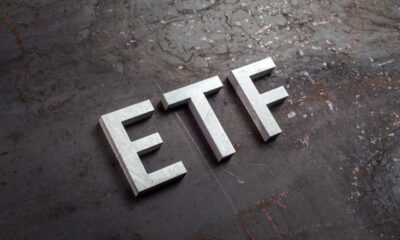

Axxion går in på den europeiska white-label-marknaden med ”modern value” fond
Nyheter
Bitcoin Warms up to Climate Goals and Ethereum’s Next Milestone: What Happened in Crypto This Week?
Publicerad
13 timmar sedanden
15 maj, 2024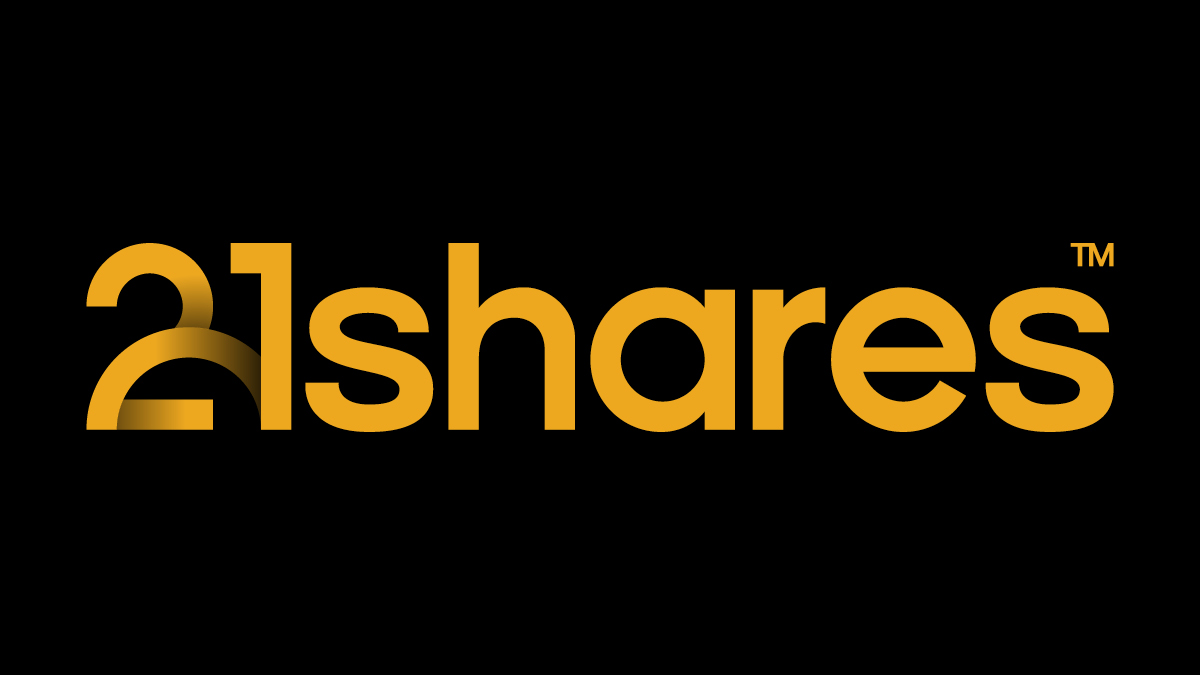
• European Economy Booms while Regulators Consider Adopting Crypto
• Bitcoin’s Growing Fundamentals and Institutionalization
• Ethereum’s Next Leap Forward: A Glimpse at the Upcoming Upgrade
European Economy Booms while Regulators Consider Adopting Crypto
Europe’s economy has exceeded expectations, with Germany’s gross domestic product (GDP) for Q1 2024 increasing by 0.2%, compared to the previous quarter’s reading of -0.5%. Additionally, France, Italy, and Spain are also seeing progress, picking up the bloc’s GDP from -0.1% to 0.3%. This is a good sign that Europe is on the right track away from a recession. Matching the positive outlook, regulators appear receptive to including new alternative assets within the EU’s most established regulatory framework.
Namely, the European Securities and Markets Authority (ESMA) is considering cryptoassets, among other asset classes like commodities and precious metals, in its Undertakings for Collective Investment in Transferable Securities (UCITS). Similar to mutual funds in the U.S., UCITS funds can be registered and sold in any country in the EU using unified regulatory and investor protection requirements. These funds are considered safe, well-regulated investments, hence their €12T market valuation and popularity among pension funds and risk-averse investors.
On May 7, ESMA invited investors and trade associations, among others, for a consultation to assess possible benefits and risks of UCITS gaining exposure to the selected 19 asset classes, having until August 7 to gather input. This is important since UCITS accounts for 75% of all collective retail investments in the EU. Thus, if the conclusions of this consultation are in favor of adopting crypto, it would attract an influx of investors and bring more regulated accessibility to this asset class. Moreover, although still under consultation, ESMA’s deliberation adds more credibility to crypto, considering the regulator’s renowned strict regulatory standards.
Further, the EU’s inflation is inching towards the 2% target, overshooting by only 0.4% in the past month, a level the U.S. is yet to achieve, with March’s inflation hitting 3.5%. Later today, a strong gauge for inflation is coming out, the Producer Price Index (PPI), measuring the change in the price of finished goods and services sold by producers. With the last consumer price index (CPI) disappointing, all eyes are on the CPI print coming out this Wednesday, along with data on retail sales. Although optimism seems to have checked out, a cooled inflation rate would recover investors’ appetite for risk-on assets like crypto, instigating more flows into Bitcoin spot ETFs, which have been especially quiet over the past week, as shown in Figure 1.
Figure 1: US Spot Bitcoin ETFs Flows

Source: Glassnode
Nevertheless, Bitcoin’s narrative has been growing beyond its primary use case as a store of value, with companies and governments alike leveraging Bitcoin mining to reduce their negative impact on the environment, ironically something Bitcoin is often scrutinized for.
Bitcoin’s Growing Fundamentals and Institutionalization
On May 7, Genesis Digital Assets and Argentina’s state-owned YPF Luz, the country’s largest producer of oil and gas with a ∼40% share in 2021, announced their opening of a Bitcoin mining facility. The data center takes ‘stranded gas,’ a byproduct of oil and gas production that would otherwise be flared and contribute to greenhouse gas emissions, to power the mining operation with the potential to reduce carbon dioxide equivalent emissions by 25-63%. Notably, 50 major oil and gas companies, representing over 40% of global petroleum production, signed the Oil and Gas Decarbonization Charter (OGDC), thereby committing to end gas flaring by 2030. The Argentinian project serves as a prime example of how companies can achieve the goals outlined in the OGDC, an approach likely to be replicated by others potentially using Bitcoin.
Aside from the obvious environmental benefits, projects like these actually strengthen Bitcoin’s network! More miners joining the fray means greater computing power, reflected by the growing hash rate in Figure 2. This results in a more secure network, as 51% attacks become more costly to execute successfully. The development comes at a crucial point in time, calming fears over miners exiting the network to cover costs, a dynamic often witnessed post-halving and one we explored in our Bitcoin Halving Report.
Figure 2 – Bitcoin Growing Hash Rate

Source: 21co on Dune
On a more familiar note, institutions continue to gobble up Bitcoin as an investment opportunity. The recent 13F filings mentioned last week revealed a growing appetite for Bitcoin as investment managers continue to disclose their U.S. equity holdings to the SEC. Quantitative trading firm Susquehanna holds over $1B in Bitcoin ETFs, with Boston-based hedge fund Bracebridge disclosing their $380M position too. Furthermore, in Japan, a weakened yen and government debt reaching 250% of GDP confirms sustained economic pressure, which has led early-stage investment firm Metaplanet to adopt Bitcoin as a strategic reserve. They have acquired over $7M since April, another testament to Bitcoin’s value proposition as a safe haven. The continuous adoption of Bitcoin is no surprise, given the accessibility of Bitcoin ETFs to traditional institutions through a regulated and familiar investment vehicle.
The positive Bitcoin sentiment is amplified by continuous innovation on the network itself. Bitcoin’s prime scaling solution, the Lightning Network, has taken a significant leap forward. By leveraging the Taproot Asset Upgrade, the Lightning Network successfully tested a protocol for issuing stablecoins directly on Bitcoin. This underscores the trend of Bitcoin’s growing use cases following the launch of Runes, which unlocked the ability to launch fungible tokens on Bitcoin. The recent surge in on-chain activity is reminiscent of the ERC-20 explosion in Ethereum’s early days, and stablecoins would truly unlock Bitcoin’s DeFi potential. They facilitate a wide range of transactions, shown below by Ethereum stablecoins amassing $3.8T in 2024 processed volume so far.
Figure 3 – Ethereum Stablecoin Volume
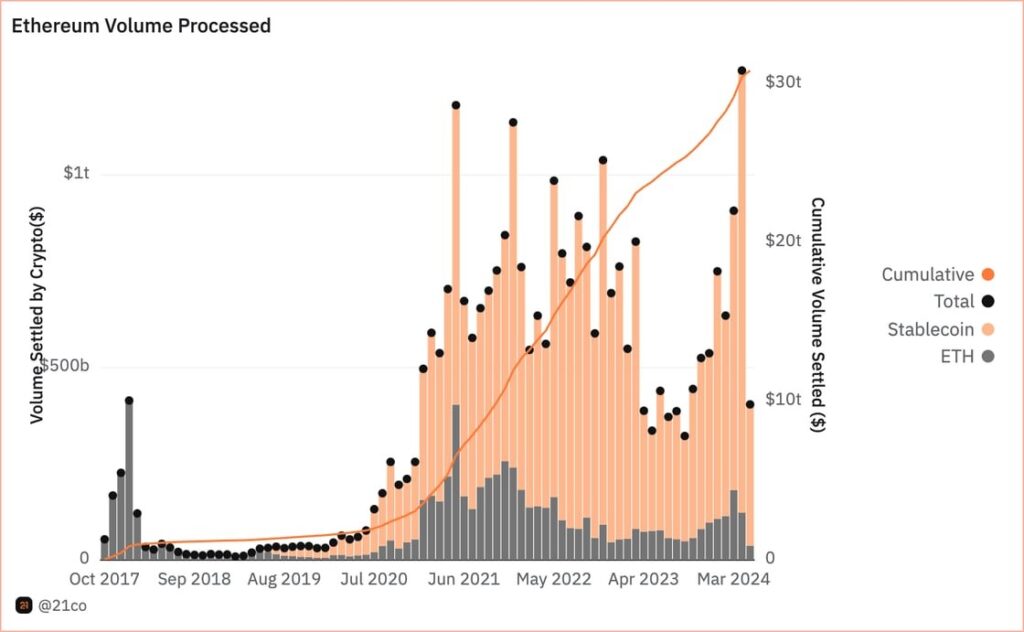
Source: 21co on Dune
While still in the early stages, this development would also significantly boost miner revenue, offering them a much-needed additional income stream through transaction fees, following the halving of block rewards last month. The potential of stablecoins on Bitcoin will be monitored going forward, as they have clear implications for the network’s potential on-chain footprint.
Ethereum’s Next Leap Forward: A Glimpse at the Upcoming Upgrade
More information is finally starting to come out regarding Ethereum’s next major upgrade, slated for late this year or early next year. Known as Pectra, the upgrade promises to introduce a range of enhancements aimed at bolstering the network’s stability and refining user experience. For example, the upgrade will raise the maximum stake per validator from 32 to 2,048 ETH, streamlining the management process for large validators who spread their stake across multiple wallets. Moreover, Pectra will tackle the problem of empty accounts, those with zero assets or funds, by removing them from the network. This action reduces the network’s state size, which effectively leads to lighter transaction processing.
Although the upgrade will incorporate various Ethereum Improvement Proposals (EIPs), one in particular stands out. Referred to as EIP 7702, Vitalik Buterin’s new proposal aims to expand upon the advancements made in Account Abstraction (AA) on Ethereum by refining certain concepts introduced in an earlier proposal, EIP 3074. As a quick recap, AA transforms users’ wallets, externally owned accounts (EOAs), into more sophisticated accounts resembling smart contracts, enhancing security, flexibility, and simplified user management. That said, EIP 7702 addresses some of EIP 3074 criticisms by steering clear of dependencies on EOA-specific functionalities. It aims to establish a versatile system capable of meeting the evolving needs of the Ethereum ecosystem while helping to reduce technical debt for the network
However, EIP 7702 proposes several other enhancements, including batched transactions, which could enhance transaction efficiency and even reduce fees by consolidating multiple user actions. Another exciting feature is the introduction of s sponsored transactions, which allow third-party applications to cover transaction fees for consumers, an ideal solution for onboarding new users. Finally, the upgrade could make users’ accounts resistant to threats from quantum computing. That said, with the proposal’s introduction of a new transaction type enabling EOAs to temporarily transition into smart accounts, concerns arise regarding the heightened risk of malicious actors’ ability to swiftly drain user wallets. Nevertheless, Vitalik’s proposal is intriguing as it charts a more pragmatic course toward realizing the AA vision. This is pivotal because it echoes our thesis at 21Shares that crypto won’t onboard millions of more users without providing them with an intuitive interface resembling the user-friendly experience they are familiar with across Web2.
Now, while Ethereum’s long-term prospects remain promising, its status as a deflationary network has come under threat in recent weeks, as seen below in Figure 3. This decline is primarily attributed to decreasing on-chain activity, which peaked at the end of March. Furthermore, the DenCun upgrade, implemented in March, significantly reduced the costs L2s incurred for storing their data on Ethereum by 90%.
Figure 4 – Ethereum’s Inflation
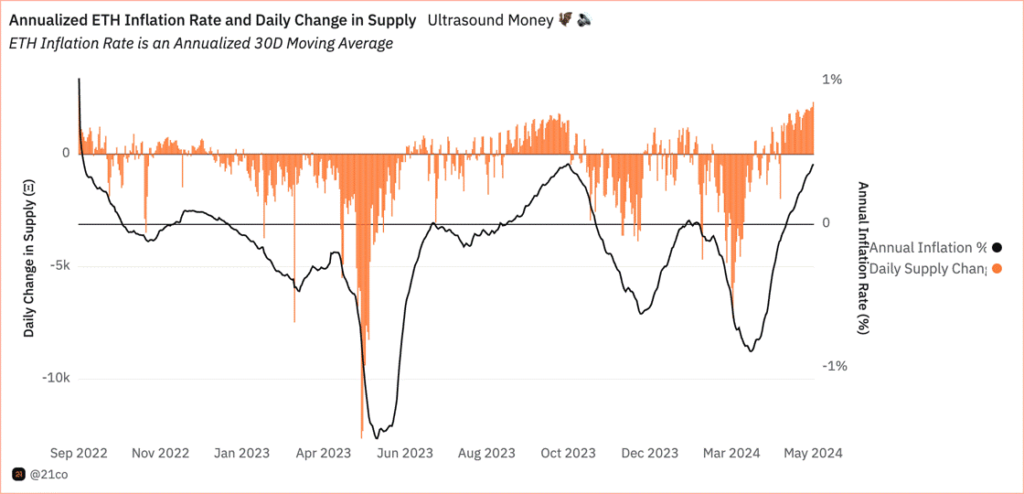
Source: 21co on Dune
It is worth noting that while it is currently more cost-effective for L2s to operate on Ethereum, these reduced costs will eventually onboard a larger user base. This will make it more feasible for applications, especially those requiring a high volume of interactions, to operate within the Ethereum ecosystem, which was previously economically unviable. A pivotal piece of evidence supporting this perspective is Arbitrum’s recent milestone, onboarding approximately 600K daily active users, as depicted in Figure 4. This likely influenced Securitize’s decision to propose deploying Blackrock’s BUIDL on Arbitrum, considering its position as the pioneering L2 platform with such a vibrant user base, alongside being the first L2 to process over $150B in swap volume on Uniswap, putting Arbitrum as the leading Ethereum scaling solution. Nevertheless, readers shouldn’t be wary, as we expect a broader spectrum of applications to arrive at the Ethereum network, helping to fill in the gap for Ethereum’s lost revenue while expanding the universe for what is possible within its ecosystem.
Figure 4 – Daily Active Users of Ethereum’s Leading Solutions

Source: GrowThePie
This Week’s Calendar
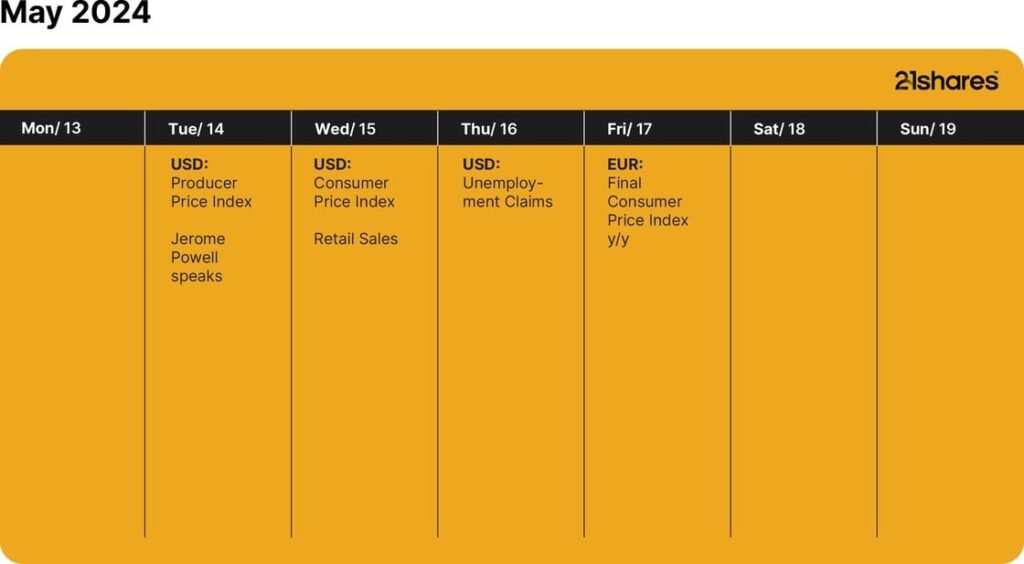
Source: Forex Factory, 21Shares
Research Newsletter
Each week the 21Shares Research team will publish our data-driven insights into the crypto asset world through this newsletter. Please direct any comments, questions, and words of feedback to research@21shares.com
Disclaimer
The information provided does not constitute a prospectus or other offering material and does not contain or constitute an offer to sell or a solicitation of any offer to buy securities in any jurisdiction. Some of the information published herein may contain forward-looking statements. Readers are cautioned that any such forward-looking statements are not guarantees of future performance and involve risks and uncertainties and that actual results may differ materially from those in the forward-looking statements as a result of various factors. The information contained herein may not be considered as economic, legal, tax or other advice and users are cautioned to base investment decisions or other decisions solely on the content hereof.
Nyheter
CRPA ETF investerar i företagsobligationer och återinvesterar utdelningen
Publicerad
14 timmar sedanden
15 maj, 2024
iShares Global Corporate Bond UCITS ETF USD (Acc) (CRPA ETF) investerar i företagsobligationer med fokus på World. ETF:n innehar hela utbudet av obligationsförfall. De underliggande obligationerna har Investment Grade-betyg. Ränteintäkterna (kupongerna) i fonden återinvesteras (ackumuleras).
Den totala kostnadskvoten uppgår till 0,20 % p.a. Fonden replikerar resultatet för det underliggande indexet genom att köpa ett urval av de mest relevanta indexbeståndsdelarna (samplingsteknik). iShares Global Corporate Bond UCITS ETF USD (Acc) har tillgångar på 116 miljoner GBP under förvaltning. ETF:en är äldre än 3 år och har sin hemvist i Irland.
Varför CRPA?
Diversifierad exponering mot globala företagsobligationer
Direktinvesteringar i företagsobligationer över sektorer (industri, allmännyttiga och finansiella företag)
Obligationsexponering med investeringsgrad
Investeringsmål
Fonden strävar efter att följa utvecklingen av ett index som består av företagsobligationer av investeringsklass från emittenter på tillväxtmarknader och utvecklade marknader.
Investeringsstrategi
Bloomberg Global Aggregate Corporate-index spårar företagsobligationer i amerikanska dollar utgivna av företag över hela världen. Alla löptider ingår. Betyg: Investment Grade.
Handla CRPA ETF
iShares Global Corporate Bond UCITS ETF USD (Acc) (CRPA ETF) är en europeisk börshandlad produkt som handlas på London Stock Exchange.
London Stock Exchange är en marknad som få svenska banker och nätmäklare erbjuder access till, men DEGIRO gör det.
Börsnoteringar
| Börs | Valuta | Kortnamn |
| gettex | EUR | SXRB |
| London Stock Exchange | USD | CRPA |
Största innehav
| Emittent | Vikt (%) |
| BANK OF AMERICA CORP | 1.83 |
| JPMORGAN CHASE & CO | 1.63 |
| GOLDMAN SACHS GROUP INC/THE | 1.29 |
| MORGAN STANLEY | 1.15 |
| CITIGROUP INC | 1.13 |
| WELLS FARGO & COMPANY | 1.12 |
| VERIZON COMMUNICATIONS INC | 0.97 |
| AT&T INC | 0.95 |
| APPLE INC | 0.84 |
| HSBC HOLDINGS PLC | 0.78 |
Innehav kan komma att förändras
Nyheter
Timely and concise insights on Bitcoin & Cryptoasset Markets
Publicerad
15 timmar sedanden
15 maj, 2024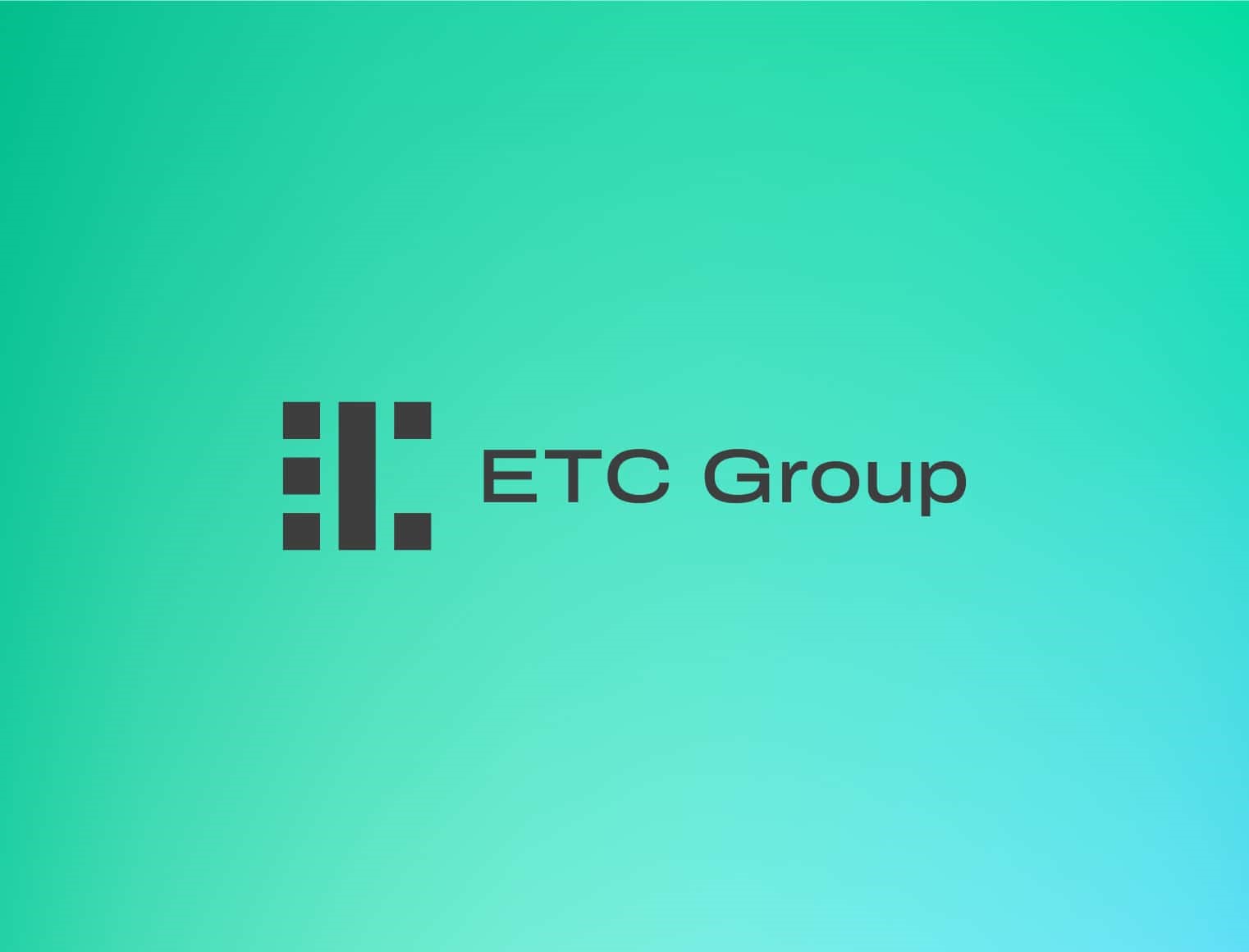
• Growing Mainstream Adoption of Digital Assets: Institutional investors and major asset managers are increasingly incorporating digital assets like Bitcoin into their portfolios, as evidenced by recent filings and the launch of Bitcoin ETFs in the U.S. Despite their current small market share, these investments reflect a broader trend towards mainstream acceptance
• Impact on Portfolio Performance: The inclusion of Bitcoin in portfolio optimizations, using strategies such as Maximum Sharpe Ratio and Risk Parity, has shown to improve the risk-adjusted returns compared to traditional portfolios. Portfolios optimized with Bitcoin not only offer higher returns for the additional risk taken but also present a wider range of efficient risk-return combinations
• Optimal Allocation Recommendations: Empirical studies suggest that even a small allocation to digital assets, specifically between 2% to 3% in broader asset mixes and up to 4% to 6% in more focused digital asset portfolios, significantly enhances portfolio performance without adversely impacting overall risk profiles
Gradually, then suddenly, as they say, digital assets are becoming mainstream.
The biggest asset managers in the world have launched spot Bitcoin ETFs in the US this year and adoption among institutional investors is rising rapidly.
Major financial institutions like Franklin Templeton themselves have just recently disclosed significant investments into Bitcoin ETFs via their latest 13F filings.
Institutional hedge funds that manage money for Ivy League university endowments have disclosed multi-million Dollar holdings. Stanford university’s Blyth Fund has recently disclosed that they hold around 7% allocation in Bitcoin ETFs.
Nonetheless, at the time of writing, US Bitcoin ETFs only account for approximately 0.6% of the overall size of the US ETF market based on data provided by ICI.
In Europe, Bitcoin ETPs also only comprise a tiny fraction of the 11 trn EUR UCITS market of only 0.05%, according to our calculations based on Bloomberg data.
In general, we expect the relative size of digital assets to increase further as even small allocations to digital assets are bound to increase portfolio risk-adjusted returns significantly as demonstrated in our latest deep dive on Bitcoin.
But what is the optimal allocation to Bitcoin and digital assets in general?
What is the optimal allocation to digital assets?
Most empirical portfolio studies usually look at how a classical 60/40 portfolio comprising of 60% allocation in stocks and 40% allocation in bonds responds to a gradual increase in digital asset allocation.
In our previous digital asset study, we did a similar exercise by investigating the effect of increases in digital asset allocation on overall portfolio risk and return metrics.
Since digital assets generally exhibit a higher risk-adjusted return (“Sharpe Ratio”) than other traditional asset classes, a marginal increase in allocation usually leads to an increase in overall portfolio risk-adjusted returns.
However, most institutional asset managers don’t employ a 60/40 portfolio in the first place because of high portfolio volatility and the dominance of the equity allocation for the whole portfolio’s risk-return profile.
In fact, most institutional asset managers in practice allocate based on optimized risk metrics such as portfolio Sharpe Ratio or portfolio volatility which is why we perform a similar exercise here.
In a first step, we looked at optimized multiasset portfolios comprising of global stocks (MSCI World AC), global bonds (Bloomberg Global Aggregate USD-hedged), and commodities (Bloomberg Commodity Index).
More specifically, we optimized these portfolios based on the following approaches:
• Minimum Variance/Volatility
• Maximum Sharpe Ratio
• Equal risk contribution (Risk parity)
The Minimum Variance approach tries to minimize the average portfolio volatility.
The Maximum Sharpe Ratio approach tries to maximize the ratio between average portfolio return (minus a risk-free return) and the corresponding average volatility. The Equal risk contribution or Risk Parity approach varies the respective portfolio weights until every asset has an identical relative contribution to the overall portfolio volatility.
In a second step, we added Bitcoin to the set of potential assets into the optimization. Our period of investigation (July 2010 – May 2024) was constrained by the fact that reliable market prices for Bitcoin only exist since 2010 as it is still a relatively young asset.
Here are the results for the different optimizations. The upper panel excludes Bitcoin while the lower panel includes Bitcoin in the optimization:

Several observations are in order:
Firstly, the minimum variance approach excludes Bitcoin completely since Bitcoin generally exhibits a higher level of volatility than the other assets.
Secondly, the maximum Sharpe Ratio approach excludes commodities in the traditional portfolio but includes Bitcoin in the new portfolio. The Bitcoin allocation is made largely at the expense of the stock allocation.
Lastly, the risk parity approach also includes Bitcoin at the expense of all other asset classes.
Furthermore, a comparison between the historical performances of the traditional portfolios that exclude Bitcoin and those that include Bitcoin reveals that the max Sharpe Ratio and the Risk Parity (ERC) portfolio were able to significantly outperform the Minimum Variance portfolio which didn’t allocate to Bitcoin at all.
It is also important to highlight that the Risk Parity portfolio with Bitcoin even exhibited a smaller maximum drawdown than the Minimum Variance portfolio without Bitcoin. In other words, the increase in portfolio volatility was largely due to an increase in positive upside volatility.
Moreover, investors are over-proportionately rewarded with higher returns for unit of additional risk as the risk-adjusted returns (“Sharpe Ratio”) increase significantly by adding Bitcoin.
The Sharpe Ratios for optimized portfolios with Bitcoin are even significantly higher than for optimized portfolios without Bitcoin.
In fact, by including Bitcoin and digital assets into their portfolio optimization, the universe of potential multiasset portfolios increases vastly.
Asset managers are not only enabled to provide investors with more efficient portfolios, i.e. higher risk-adjusted returns, but also provide investors with a much larger set of risk-return combinations compared to traditional portfolios that only include stocks, bonds, and commodities.
So far so good. What about other digital assets?
We also applied the same portfolio optimization approaches to a basket of the top 20 digital assets based on the MSCI Global Digital Assets Select 20 Capped Index.
–> The optimal % allocation is even higher in case of the Maximum Sharpe Ratio and Risk Parity portfolio optimization.
It is important to note that the period of investigation (November 2019 – May 2024) is much smaller due to the fact that younger digital assets within the top 20 digital assets like Solana or Ethereum have a smaller track record than Bitcoin.
All in all, the abovementioned results imply that even a small allocation to digital assets can have very positive effects on risk-adjusted returns without compromising the risk characteristics of the portfolios.
While highly risk-averse investors should probably avoid digital assets, the optimal allocation based on the Max Sharpe Ratio and Risk Parity approach appears to be between 2% and 3% for the full sample with bitcoin and between 4% and 6% for the smaller sample with a basket of the top 20 digital assets.
The results generally support our previous findings that we presented here.
Most portfolio optimization approaches also include digital assets within the optimal portfolio allocation which demonstrates that any modern portfolio approach that doesn’t include digital assets like Bitcoin is probably sub-optimal.
We recommend that agile asset managers familiarise themselves with this emerging asset class for the benefit of their clients and to remain competitive.
Bottom Line
• Growing Mainstream Adoption of Digital Assets: Institutional investors and major asset managers are increasingly incorporating digital assets like Bitcoin into their portfolios, as evidenced by recent filings and the launch of Bitcoin ETFs in the U.S. Despite their current small market share, these investments reflect a broader trend towards mainstream acceptance
• Impact on Portfolio Performance: The inclusion of Bitcoin in portfolio optimizations, using strategies such as Maximum Sharpe Ratio and Risk Parity, has shown to improve the risk-adjusted returns compared to traditional portfolios. Portfolios optimized with Bitcoin not only offer higher returns for the additional risk taken but also present a wider range of efficient risk-return combinations
• Optimal Allocation Recommendations: Empirical studies suggest that even a small allocation to digital assets, specifically between 2% to 3% in broader asset mixes and up to 4% to 6% in more focused digital asset portfolios, significantly enhances portfolio performance without adversely impacting overall risk profiles
To read our Crypto Market Compass in full, please click the button below:


Bitcoin Warms up to Climate Goals and Ethereum’s Next Milestone: What Happened in Crypto This Week?

CRPA ETF investerar i företagsobligationer och återinvesterar utdelningen

Timely and concise insights on Bitcoin & Cryptoasset Markets

Valour Inc. lanserar världens första avkastningsbärande Bitcoin (BTC) ETP

Virtune lanserar Virtune Staked Cardano ETP på Nasdaq Stockholm

ETFmarknaden i Europa firar sitt 24-årsjubileum med tillgångar på två biljoner USD

Vilken är den bästa fond som följer Nasdaq-100?

Några av de bästa guldfonderna

De mest populära börshandlade fonderna april 2024

Sveriges enda riktiga råvarufond har öppnat
Populära
-

 Nyheter4 veckor sedan
Nyheter4 veckor sedanETFmarknaden i Europa firar sitt 24-årsjubileum med tillgångar på två biljoner USD
-

 Nyheter2 veckor sedan
Nyheter2 veckor sedanVilken är den bästa fond som följer Nasdaq-100?
-

 Nyheter2 veckor sedan
Nyheter2 veckor sedanNågra av de bästa guldfonderna
-

 Nyheter2 veckor sedan
Nyheter2 veckor sedanDe mest populära börshandlade fonderna april 2024
-

 Nyheter4 dagar sedan
Nyheter4 dagar sedanSveriges enda riktiga råvarufond har öppnat
-

 Nyheter1 vecka sedan
Nyheter1 vecka sedanEndast en tredjedel av brittiska privatinvesterare har hört talas om ansvarsfulla investeringar eller ESG
-

 Nyheter3 veckor sedan
Nyheter3 veckor sedanU.S. Global Investors tar över HANetf Travel
-
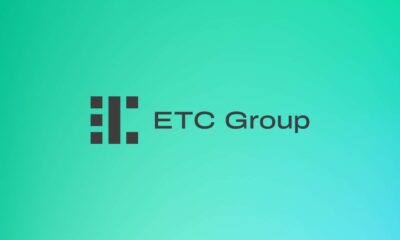
 Nyheter2 veckor sedan
Nyheter2 veckor sedanBTC1 ETP spårar priset på kryptovalutan Bitcoin



